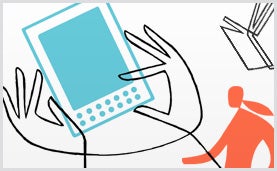
Who are eBook consumers and what are their reading habits? These questions are frequently posed to the Random House Research and Analytics team, and fortunately we have some great sources for understanding this technology-savvy group. One of those resources is data that we acquire through regular surveys of U.S. book consumers, which we can filter to look solely at eBook consumers. This has enabled us to get a good picture of who they are and their attitudes toward books and reading. What emerges is a portrait of the highly engaged reader: avid readers across digital and print formats, and technology “fast-forwards” who are more accessible than ever via both online and offline touch points.
Over a fifth of American adults have read an eBook. EBook consumers are likely to be book enthusiasts who read across digital and print formats. Most eBook consumers are women, are younger than forty-five, have college degrees or have had some college education, and have upscale incomes. EBook consumers are over 20 percent more likely to have household incomes over $100,000 per year than non-eBook consumers. Preferred genres include mystery/suspense/detective fiction, general fiction, and romance.
EBook consumers stand out in a number of ways from non-eBook consumers. EBook consumers are 2.5 times more likely to own a tablet than non-eBook consumers. They also tend to be more accessible than non-eBook consumers across online touch points, and more sensitive to word-of-mouth recommendations. According to a recent survey by the Pew Research Center, Internet-savvy owners of eReading devices, when compared to the general population, are more likely to get recommendations from online bookstores or other websites (56 percent versus 34 percent for the general reading population). When compared to all Americans ages sixteen and up, they tend to rely more heavily on word-of-mouth (81 percent versus 64 percent for all Americans ages 16+) and bookstore staff (31 percent versus 23 percent for Americans ages 16+) for book recommendations.
What does this mean for authors?
Well, it means that developing your presence and building buzz across a wide range of online platforms where eBook consumers can be reached (including your website, blog, social networks, and reading-focused sites) will become increasingly important as eBook and eReading device adoption continues to grow.


